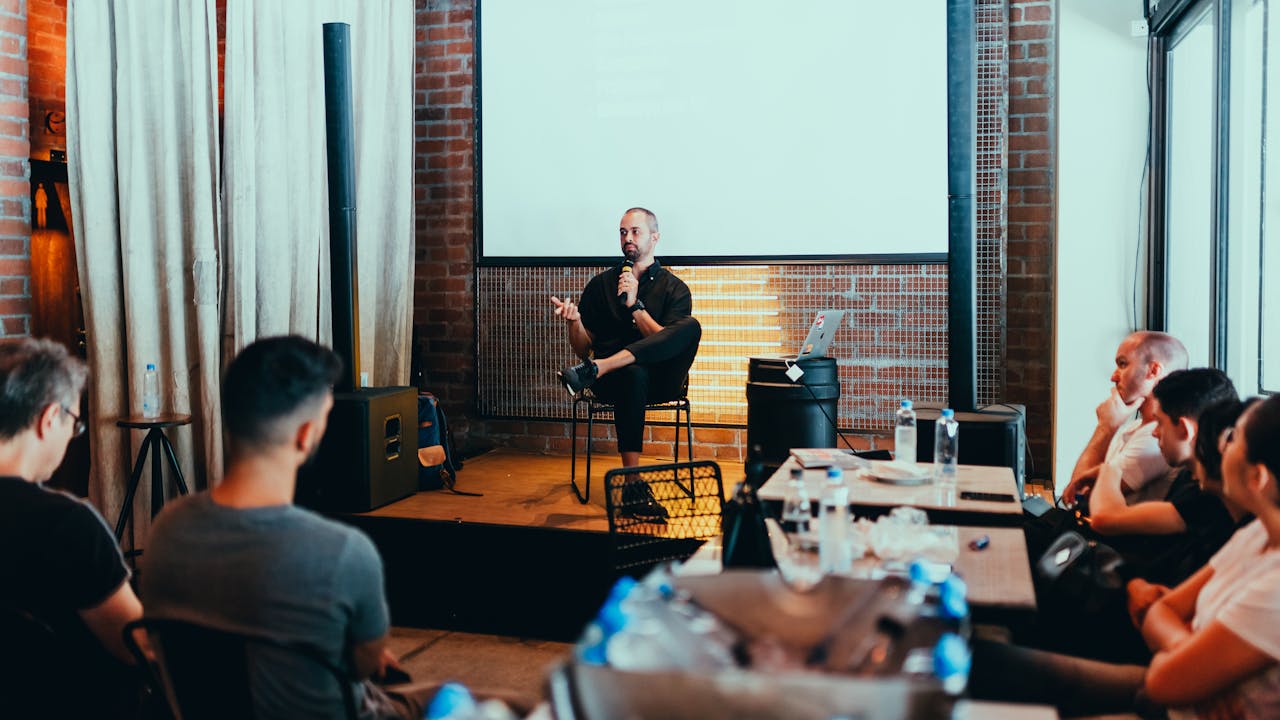The event marketing world has reached an inflection point. What worked two years ago—standard booths, generic agendas, passive attendees—no longer cuts through the noise. Today’s event professionals face a different reality: audiences expect experiences tailored to their interests, technology that feels natural rather than forced, and engagement opportunities that extend beyond a single day in a convention center. The stakes have risen. Events now serve as critical touchpoints in broader marketing strategies, with measurable impact on brand perception, customer loyalty, and revenue. For those willing to adapt, the opportunities are significant. For those who resist, irrelevance looms.
PR Overview
Building Immersive Experiences That Actually Matter
Immersive technology has moved from novelty to necessity. AR and VR are no longer experimental add-ons reserved for tech giants with unlimited budgets. They’ve become standard tools for creating memorable event experiences that engage attendees on multiple sensory levels.
Apple’s approach at WWDC demonstrates the power of this shift. By incorporating AR and VR elements, they allow attendees to interact with new products in digital environments before physical versions hit the market. This isn’t just flashy showmanship—it’s strategic. Attendees leave with a deeper understanding of product capabilities and a stronger emotional connection to the brand. The experience becomes the message.
The key lies in integration, not isolation. Immersive elements work best when they serve a clear purpose within the broader event narrative. A VR demo that exists solely because “everyone’s doing VR” will fall flat. But when that same technology allows attendees to visualize complex data, explore product features in three dimensions, or participate in scenarios impossible in the physical world, it becomes indispensable.
Event technology platforms have simplified implementation considerably. Modern systems offer seamless integration of AR and VR components, interactive elements, and live audience responses. This means smaller organizations can now deploy immersive experiences without requiring dedicated technical teams or massive budgets. The barrier to entry has dropped, but the bar for quality remains high.
The most successful implementations blend physical and digital worlds naturally. Attendees shouldn’t feel like they’re switching between two separate experiences. When done right, the technology fades into the background, and the content takes center stage. That’s when immersion becomes engagement.
Personalization at Scale: Moving Beyond Segmentation
Generic event experiences are dead. Attendees now expect content, networking opportunities, and agendas tailored to their specific interests and professional needs. Meeting this expectation requires more than basic segmentation—it demands sophisticated data analysis and AI-powered tools that can deliver personalization at scale.
The business case is clear. Organizations using data-driven personalization see measurable improvements in attendee satisfaction, increased loyalty, and stronger ROI. Generative AI has become a strategic asset for event marketers, enabling them to tailor content and experiences in ways that were previously impossible or prohibitively expensive.
AI-driven personalization now powers everything from agenda recommendations to communication strategies. Event management software can analyze attendee data—registration information, past behavior, engagement patterns—and use that intelligence to suggest sessions, recommend networking connections, and deliver content that matches individual interests. This isn’t about bombarding attendees with options; it’s about curating experiences that feel personally relevant.
The shift requires a fundamental change in how events are designed. Rather than building a single experience for all attendees, successful event marketers now create flexible frameworks that adapt to individual needs. This approach treats events as part of a holistic marketing strategy, with personalization integrated across all touchpoints—from pre-event communications to post-event follow-up.
Implementation starts with data collection and analysis. What information do you need to deliver meaningful personalization? How will you gather it without creating friction in the registration process? What tools will you use to turn raw data into actionable insights? These questions must be answered before the first invitation goes out.
Privacy considerations matter here. Attendees will share data if they understand the value exchange. Be transparent about what you’re collecting and how it will improve their experience. The organizations that handle this balance well build trust; those that don’t face backlash and disengagement.
Wearable Technology: From Tracking to Transformation
Smart badges and wristbands have evolved from simple identification tools into powerful engagement platforms. Wearable technology now tracks attendee movements, facilitates networking, enables gamification, and collects real-time data that helps organizers optimize events as they unfold.
The applications extend far beyond attendance tracking. Wearables can unlock rewards, trigger personalized content delivery, and create seamless hybrid event participation. When integrated with event management software, these devices become the connective tissue that binds physical and digital experiences together.
Real-time engagement represents one of the most valuable use cases. Wearables enable live polls, instant Q&A sessions, and immediate feedback collection. Attendees can interact with speakers and each other without pulling out phones or navigating apps. The friction disappears, and participation increases.
For event organizers, the data generated by wearables provides unprecedented insight into attendee behavior. Which sessions attracted the most engagement? Where did people spend their time? Which networking areas saw the most activity? This intelligence informs not just post-event analysis but real-time adjustments. If a session is underperforming, you know immediately. If a networking area is overcrowded, you can redirect traffic.
The networking benefits deserve special attention. Wearables can facilitate introductions based on shared interests, professional goals, or complementary expertise. They can notify attendees when valuable connections are nearby. This transforms networking from a random, often awkward process into a strategic, data-informed activity.
Privacy and data security remain critical considerations. Attendees need to understand what’s being tracked and how that information will be used. Opt-in mechanisms, clear privacy policies, and transparent data practices aren’t just legal requirements—they’re trust-building opportunities.
Hybrid Events: The New Standard, Not the Exception
The debate over hybrid versus in-person events has ended. Hybrid is now the default format for organizations serious about maximizing reach and engagement. The question is no longer whether to offer virtual participation but how to create seamless experiences for both physical and digital attendees.
Done poorly, hybrid events feel like two separate experiences awkwardly stapled together. Virtual attendees watch passively while in-person participants enjoy the “real” event. This approach satisfies no one and undermines the entire value proposition.
Done well, hybrid events create integrated experiences where both audiences feel equally valued and engaged. This requires intentional design, appropriate technology, and a commitment to serving both groups throughout the event lifecycle.
Live streaming forms the foundation, but it’s just the starting point. Virtual attendees need opportunities to participate in breakout sessions, engage in networking activities, and interact with content in meaningful ways. Event management software plays a critical role here, organizing the logistics and ensuring that both audiences can access the same opportunities.
The reach potential is significant. While in-person events might attract hundreds or thousands of attendees, hybrid formats can extend that audience to millions of viewers worldwide. This expanded reach doesn’t dilute the experience—it amplifies impact and extends brand influence far beyond the physical venue.
The key is treating virtual participation as a first-class experience, not an afterthought. This means investing in quality production, creating interactive opportunities specifically for remote attendees, and ensuring that virtual participants can connect with both speakers and other attendees. When virtual attendees feel like they’re missing out, you’ve failed. When they feel like they’ve gained access to something valuable, you’ve succeeded.
Gamification and Real-Time Engagement: Maintaining Momentum
Attention is the scarcest resource at any event. Gamification and real-time engagement tools help event marketers capture and maintain that attention throughout the event lifecycle—before, during, and after the main programming.
The Docker Dash game at DockerCon provides a compelling example. This scavenger hunt-style game increased brand awareness and attendee participation by turning passive observation into active engagement. Participants weren’t just attending sessions; they were completing challenges, earning points, and competing on leaderboards. The event became an experience worth talking about.
Gamification mechanics—quizzes, challenges, leaderboards, reward systems—tap into fundamental human psychology. People like competition, achievement, and recognition. When these elements align with event objectives and brand messaging, they drive behavior in predictable, measurable ways.
The technology supporting gamification has matured significantly. Event platforms now offer built-in gamification features, credit systems, and interactive elements that require minimal setup. This accessibility means even smaller events can deploy sophisticated engagement strategies without extensive technical resources.
Real-time engagement tools complement gamification by creating moments of shared experience. Live polls allow attendees to voice opinions instantly. Q&A sessions give everyone a chance to participate in conversations with speakers. These tools transform events from one-way broadcasts into dynamic, participatory experiences.
The measurement capabilities matter as much as the engagement itself. Gamification and real-time tools generate data that reveals what’s working and what’s not. Which activities drove the most participation? Which sessions generated the most questions? This intelligence informs not just post-event analysis but future event design.
The most effective implementations align gamification with brand objectives. Random games might generate short-term engagement, but strategic gamification reinforces key messages, educates attendees about products or services, and creates memorable associations with the brand. The game becomes a vehicle for deeper engagement, not just a distraction.
The event marketing profession stands at a crossroads. The tools, technologies, and strategies outlined here aren’t optional enhancements—they’re requirements for relevance today and in the future. Immersive experiences, personalized agendas, wearable technology, hybrid formats, and gamification have moved from experimental to expected.
Success requires more than adopting new tools. It demands a fundamental shift in how we think about events. They’re no longer standalone activities but integrated components of broader marketing strategies. They’re no longer one-size-fits-all productions but personalized experiences tailored to individual needs. They’re no longer confined to physical venues but extended through technology to global audiences.
Start by auditing your current approach. Where are the gaps? Which of these strategies could deliver the most immediate impact for your organization? Then build a roadmap for implementation, prioritizing investments that align with your specific goals and audience needs. The organizations that move decisively will gain competitive advantages that compound over time. Those that wait will find themselves struggling to catch up in a market that rewards innovation and punishes complacency.
Future Trends in Event Marketing and PR
The event marketing world has reached an inflection point. What worked two years ago—standard...
Leveraging Social Media To Engage Health-Conscious Consumers
Health-conscious consumers represent one of the fastest-growing audience segments on social media,...
The Role of Gamification in Digital Health Engagement
Health apps sit on millions of phones, downloaded with good intentions but rarely opened after the...


